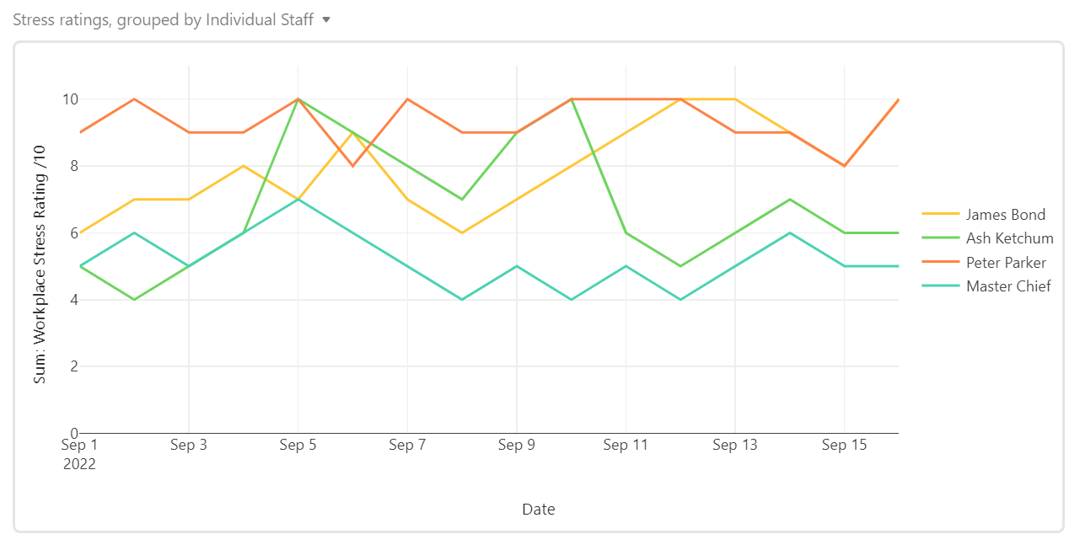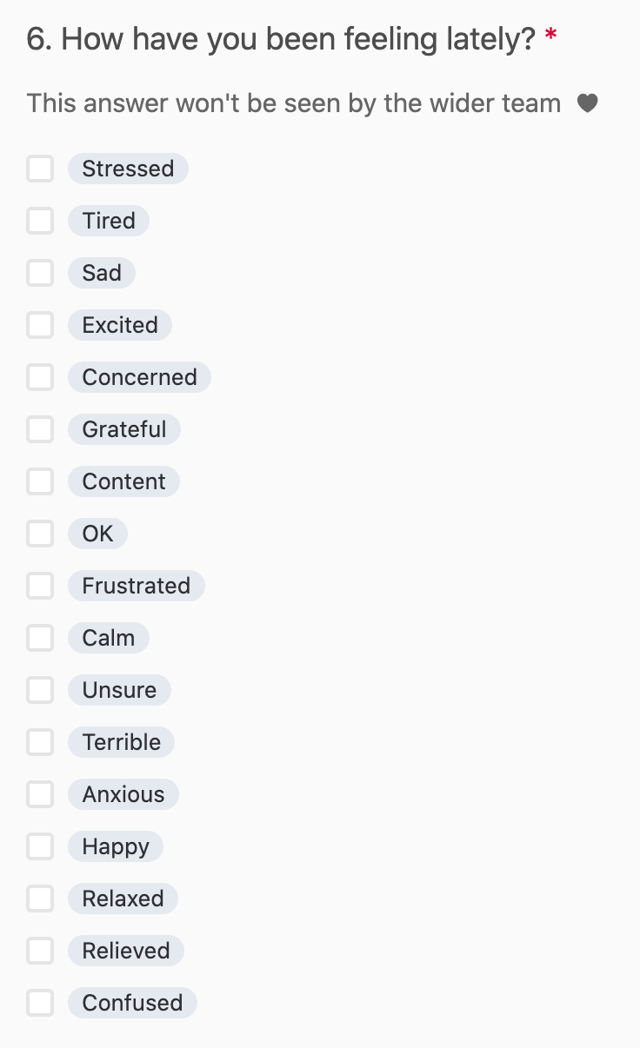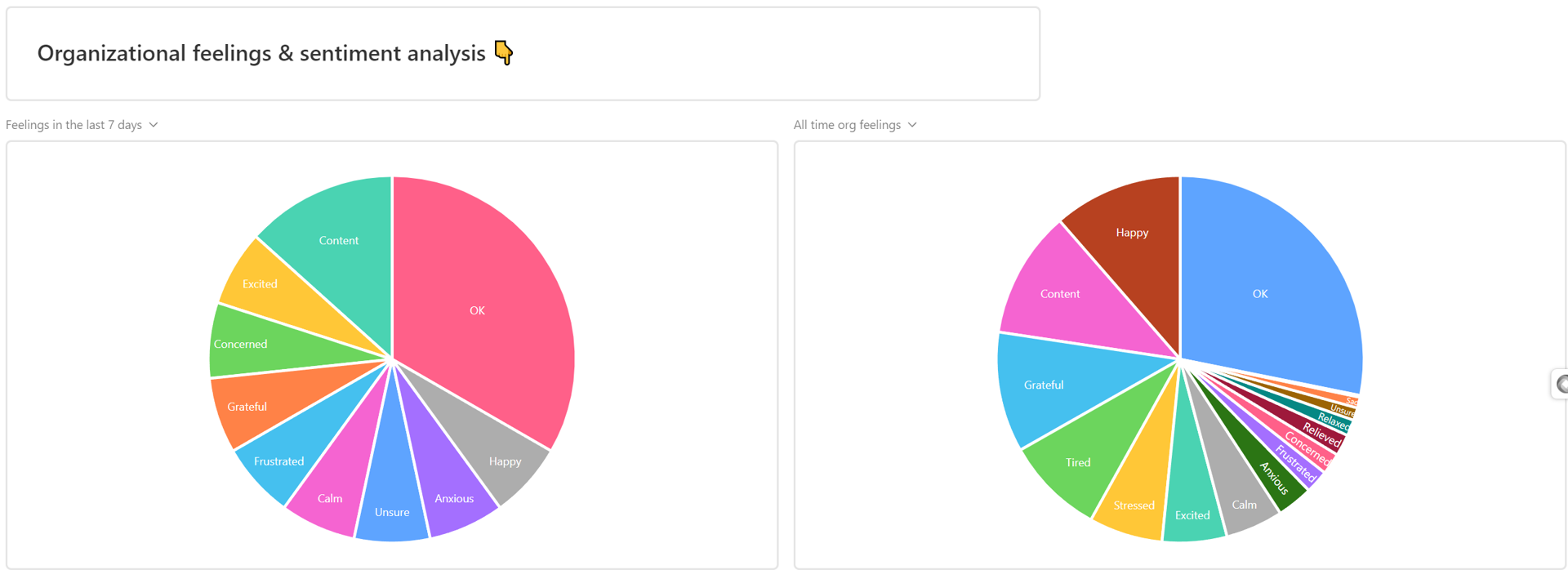
2 tips for happier, more productive & innovative remote team
Two most cited problems with remote teams are:
- Losing the serendipitous innovations that come with staff talking in the office.
- Managers and colleagues often have less personal and deep relationships.
These problems then lead to:
- Lower staff retention rates,
- Lower team motivation and morale,
- Fewer innovations and efficiency improvements.
Below are two tips to solve or reduce these problems...
Tip 1:
Introduce a weekly stand-up form that allows staff to leave stress ratings, feedback, and more...
The problem:
In a recent venture, we began rapidly scaling from sudden growth via a strategic new partner. The problem this caused was high stress for our operations and services team to recruit new team members, train them, and then manage quality while delivering our services. This led to inefficient resource allocation due to many sudden changes required across departments. As a result, we have increased error rates from the pressures of sudden scaling and lowered morale from our core staff who had not been promoted with the growth.
A helpful, partial solution:
We introduced our own take on weekly stand-ups, here's how it worked... First, we created a form that all staff members filled out every Monday morning. This form had 8 questions, and answers to the first 3 were viewable to the whole organization. Answers to questions 4 and onward were visible only to management. This was all automated via Zapier integrations with Slack and AirTable. The form was hosted on AirTable and circulated to the team at 9am to remind them to fill this out. At mid-day, the whole organization was then sent a link to see everyone's answers to the first 3 questions of the stand-up form.
The form included questions like:
- What work or non-work thing happened in the last week that made you smile?
- What are your top priorities for this week?
- What's a win or update from your work last week?
- How capable do you feel of maintaining your workload? This question provided a dropdown selection of responses to help identify what team members have spare capacity, and who might need help with their workload.
- How have you been feeling lately?
- How stressed are you with your current work?
- Anything you want to add or share about how you feel?
- Do you have any concerns or suggestions for changes that can be made at any level and across the organization?
Below are the benefits of using a form like this:
Benefit 1: Help foster personal connections across team members.
The aim of the first question, "What work or non-work thing happened in the last week that made you smile?", is to encourage personal connections within teams. As this answer is shared with both the line manager and the wider org, it can be a fun way to get to know team members in different teams that you usually have no communication with. It also serves as a talking point for line managers to use with their team members in 1 to 1 sync-up meetings. This was especially helpful for managers who struggle to get personal with remote team members, this is because it made it easy for them to get to know each other personally and to start not-work-related conversations.
Benefit 2: Turn stress ratings into insights for management.
For question 6, all answers are given in a numerical-only field. Staff are given context to base their self-reporting, such as 5 being normal, manageable day-to-day BAU stress levels, while 10 indicates immediate assistance is needed. Having team members self-report stress ratings in weekly stand-up forms provides valuable insights for managers. For example, if these forms are done via AirTable you can easily create graphs based on this to help gain deeper insights on your teams. For example, on the graph below we can see Peter Parker has been reporting 9-10 stress ratings for the past few weeks. He might need support before he burns out and quits.
You can also group all your team's stress ratings by things like managers and departments for deeper insights, like in the graphs below (click to expand).
For example, below (click to expand) we can see staff managed by Thanos are very stressed on average, so Thanos may need management support. On the other side, the staff managed by Michael Scott are very happy, so this might indicate he has valuable learnings to share.
You can also group by department, like in the graph above (click to expand). If some departments have high-stress ratings it could indicate which departments may need to be looked at for readjustments, as well as providing signals for things that should be changed/optimized. Likewise, those with lower stress ratings could be learning sources, as those departments or managers might be using better management styles, or better systems and processes.
Having a stress rating number also helps managers who are less emotionally intuitive to better empathize with and understand their teams. This then helps in many ways ongoing, like improving communications with teams.
Benefit 3: Keep the entire organization up to date in an efficient way.
With questions like: "What are your top priorities for this week?" and it's answers being made public to the org, it made it much easier for teams across departments to stay in sync. This thus becomes a very efficient way to keep your whole team in sync with everyone from all other departments. With this, teams working in other departments can now have visibility into each other's work and priorities, this then enables greater cross-team working and collaboration.
Benefit 4: Empower staff to share ideas, suggestions & concerns.
Having a specific, consistent space for staff to share ideas both encourages & facilitates innovation in the organization. This can also be helpful to identify high-performers at scale, especially those whose talents may be not be being nurtured by their line manager, or as a result of that team or division's work cultures.
As you should give some internal company updates along with this form, including things like wins and new plans, this can also become a way to retain and grow along with your high-performing talent. This comes if you also encourage staff to take the initiative should they want to suggest proposals for projects that allign with what the company is looking to achieve (based on the updates you give). This can be a great way to retain staff who are ambitious and looking for more self-actualization and career growth.
Benefit 5: Have a clear view in to your teams capacity, and use of resources.
With questions like: "How capable do you feel of maintaining your workload?", managers are able to get insights into how to better use team resources. This question uses a dropdown selection for staff to self-report their week-to-week changes in capacity, this makes it very easy for you and your management team to make team planning and capacity decisions. By having a recurring safe space for individuals to self-report this your management teams no longer have to guess, estimate or spend hours calculating the team's capacity.
Benefit 6: Create a more empathetic work environment.
The question "How have you been feeling lately?", allows staff to choose from a pre-written choice of emotions. From this, managers of all EQ levels can have better empathy and communication with their team members. More importantly, staff who may not feel comfortable sharing negative emotions in meetings can get a medium to professionally share if they have any issues from their personal lives that might be affecting their moods at work. With this information, managers can then better understand and adapt to the emotional needs of their teams. Below is an example of the emotions that can be selected:
Tip 2:
Onboard staff with cross-team mentors & rich introductions
Most companies have very basic onboarding systems. This is how it usually goes:
- You get added to the main internal comms channels, such as Slack etc
- You get tagged and mass introduced to the team, usually just saying your name + what you do
- You get a bunch of generic “welcome to the team!” messages
- You get all the documentation and tools for onboarding
- You have calls with your new colleagues, and depending on the other person’s social skills you either gradually find common ground, or you have a “highly efficient” remote relationship
Basic onboarding systems like this can damage company culture and inter-team relationships for many reasons.
For example: In the above stereotypical onboarding experience, the wider team has no idea who the new hire is (apart from their name + what they do). That means Bob in marketing will never even know what Lisa in engineering is like - worse yet, they may never even interact. This naturally limits inter-team bonding and cross-department innovation and knowledge sharing.
Instead, you can solve many of these problems by…
1. Giving new team members a mentor in another department.
The benefits of this approach include:
- This encourages cross-team conversations, innovations & knowledge sharing.
- This also allows the new team member to have a point person to go to for questions/concerns. For example, if the new joiner feels insecure asking certain questions they can do this with their assigned mentor. This also helps in instances of staff unsure how to go about asking and seeking career growth opportunities & more.
2. Giving new hires rich intros via personality-focused onboarding forms
This can be as simple as a form that asks new hires about things like hobbies, interests, pets etc. Then, when introducing new hires share these answers with the rest of the team so they can have richer introductions - vs bland "welcome to the team!".
For example: If I mention in my answers that I love Age of Empires, reading about UFOs, and listening to Beedle the Bardcore, another team member might find this interesting and may then comment on one of these. This can then lead to a much richer and meaningful interaction. Otherwise, typical intros usually just result in generic “hi”’s and “welcome!” messages. Therefore, including a place to share things like pictures of pets on this form is also a great way to get more genuine inter-team bonding for new hires and cross-team relationships.

















